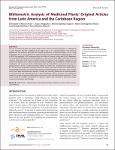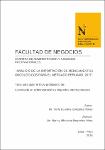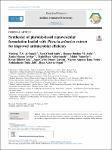Mostrar el registro sencillo del ítem
Bibliometric Analysis of Medicinal Plants’ Original Articles from Latin America and the Caribbean Region
| dc.contributor.author | Alarcon Ruiz, Christoper A. | |
| dc.contributor.author | Maguiña, Jorge L. | |
| dc.contributor.author | Apolaya Segura, Moises | |
| dc.contributor.author | Carhuapoma Yance, Mario | |
| dc.contributor.author | Aranda Ventrura, Jose | |
| dc.contributor.author | Herrera Añazco, Percy | |
| dc.date.accessioned | 2023-10-18T17:47:15Z | |
| dc.date.available | 2023-10-18T17:47:15Z | |
| dc.date.issued | 2023-02-10 | |
| dc.identifier.citation | Alarcon, C. A., Maguiña, J. L., Apolaya, M., Carhuapoma, M., Aranda, J., & Herrera, P. (2023). Bibliometric Analysis of Medicinal Plants’ Original Articles from Latin America and the Caribbean Region. Journal of Scientometric Research, 12(1), 79-91. https://doi.org/10.5530/jscires.12.1.011 | es_PE |
| dc.identifier.other | . | es_PE |
| dc.identifier.uri | https://hdl.handle.net/11537/34601 | |
| dc.description.abstract | The use of medicinal plants by health professionals and the general population is widespread in Latin America and the Caribbean (LAC) region due to its cultural tradition and extensive biodiversity. We aimed to describe the scientific production of medicinal plants in LAC, using bibliometric and co-words analysis for original articles from three databases published from 1970 to 2020. We analyzed 14,397 original articles from Web of Science, Scielo, and LILACS databases. Annual scientific production of medicinal plants in LAC increased from 2000 to 2010 but remained constant. More than half of the included articles had authors from Brazilian institutions, but articles with authors from Cuban institutions had the highest rate of articles per million country inhabitants. LAC countries mostly collaborated with the United States and western Europe. Ilex paraguariensis A.St.-Hil., Uncaria tomentosa (Willd. ex Schult.) DC., and Baccharis trimera (Less.) DC. are the most frequently mentioned medicinal plants. We observed the anti-inflammatory, antimicrobial, antitumor, and antioxidant activity of medicinal plants assessed in these studies, mostly from basic and laboratory research. Overall, the scientific production of medicinal plants in LAC increased and assessed most of its main therapeutic effects. However, more efforts are needed to increase regional collaboration and promote clinical and translational research. These results could be valuable information for decision-makers and scientists to determine future research prioritization and funding. | es_PE |
| dc.format | application/pdf | es_PE |
| dc.language.iso | eng | es_PE |
| dc.publisher | Phcog.Net | es_PE |
| dc.rights | info:eu-repo/semantics/openAccess | es_PE |
| dc.rights | Atribución-NoComercial-CompartirIgual 3.0 Estados Unidos de América | * |
| dc.rights.uri | https://creativecommons.org/licenses/by-nc-sa/3.0/us/ | * |
| dc.source | Universidad Privada del Norte | es_PE |
| dc.source | Repositorio Institucional - UPN | es_PE |
| dc.subject | Bibliometric | es_PE |
| dc.subject | Phytotherapy | es_PE |
| dc.subject | Ethnopharmacology | es_PE |
| dc.subject | Medicinal plants | es_PE |
| dc.subject | Plant extracts | es_PE |
| dc.subject | Latin America | es_PE |
| dc.title | Bibliometric Analysis of Medicinal Plants’ Original Articles from Latin America and the Caribbean Region | es_PE |
| dc.type | info:eu-repo/semantics/article | es_PE |
| dc.publisher.country | PE | es_PE |
| dc.identifier.journal | Journal of Scientometric Research | es_PE |
| dc.description.peer-review | Revisión por pares | es_PE |
| dc.subject.ocde | https://purl.org/pe-repo/ocde/ford#3.01.00 | es_PE |
| dc.description.sede | Breña | es_PE |
| dc.identifier.doi | https://doi.org/10.5530/jscires.12.1.011 |






